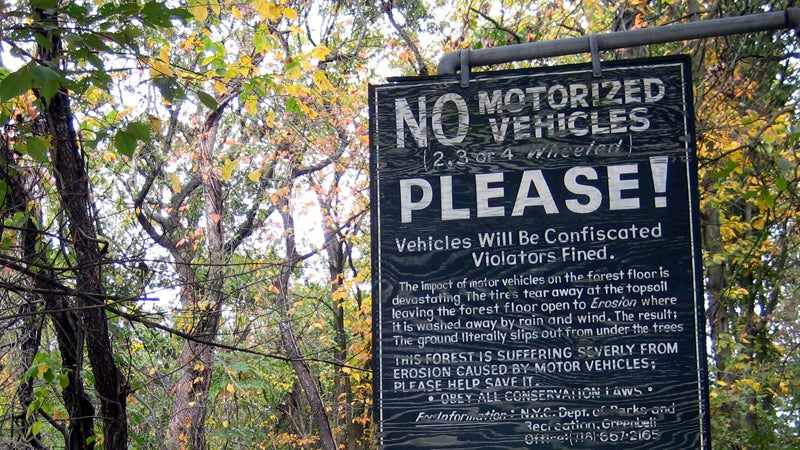What is it about a well-armed, ragtag militia confronting—and threatening—government officials (and ready to use ) that gets everyone so fired up?
On Saturday, we’ll get to witness more of these shenanigans, or something like it, this time at Recapture Canyon in southeast Utah. That’s where Phil Lyman, the commissioner of San Juan County, is who are spitting mad that the Bureau of Land Management has restricted use of motorized all-terrain vehicles (citing damage to the landscape and vandalism of archeological sites).
The protestors plan to throttle into the 11-mile-long canyon, which is clearly posted with “no motorized vehicle” signs. No word yet on whether they will also be flexing their second amendment rights. The BLM, FBI, and San Juan County Sheriff’s office have said they will “stand down,” but BLM-Utah stated that they would “seek all appropriate criminal and civil penalties.” The canyon contains ancient Anasazi ruins and other notable archaeological features. It was closed to motorized use in 2007 after ATV users built an illegal 7-mile-long trail in the canyon.
Whatever kind of showdown ensues, in the end it may not be the gun-toting anti-federalists that present the largest threat to the best use of public lands in the West. Often these groups are small factions of conservatives either wittingly or unwittingly doing the dirty work of some much bigger, more powerful players. Based on , oil and gas companies may be pulling the strings behind these localized, and more sensationalized, confrontations—a la the recent Cliven Bundy debacle in Nevada.
Staging protests, stirring anti-government sentiment, and pushing for access into protected wildland serve the larger interests of the extractive-resource industry by challenging the control that the Federal government has on public lands—whether that happens in Recapture Canyon or in a lobbyist’s watering hole on K Street.
The CAP report details shows how oil and gas companies are leveraging three groups in particular—, (CSF), and the(NRA)—to attain “an increasingly active and vocal role in advancing energy industry priorities, even when those positions are in apparent conflict with the interests of hunters and anglers who are their rank-and-file members.”
Whatever kind of showdown ensues, in the end it may not be the gun-toting anti-federalists that present the largest threat to the best use of public lands in the West.
The oil and gas industry’s lobbying efforts went into high gear at the start of Obama’s first term and have totaled nearly $900 million since 2008, compared to around $400 million from 2002 to 2007, according to Center for Responsible Politics. The CAP report asserts that sportsmen’s clubs are among the industry’s targets because financial support buys access to political operatives, and even members of Congress, who have ties to the sportsmen and gun rights community. That, in turn, allows the industry to push, through these clubs, for oil and gas interests in public land and wildlife policy—even when those positions are not in line with sportsmen’s general stance, which (on paper, at least) focuses on conservation and open lands access.
A hunting and fishing industry representative says report explains a lot. “The NRA and the Safari Club are taking positions that are not in the best interests of sportsmen,” says the individual, who asked to remain anonymous. “People were wondering why and thought it was because they were taking dollars from fossil fuel industry, but there was never a smoking gun. This report provides that.”
The report calls out three specific areas where the energy industry is seeking influence: the government’s upcoming final decision (due next year) on whether to list the greater sage grouse and lesser prairie chicken—which would likely limit oil and gas exploration permits; decisions on roadless areas which could hamper or open opportunities to backcountry energy development; and issues relating to closing public access to roads or hunting grounds.
Since 2010, according to the report, 28 energy companies have contributed to the NRA and the CSF. Shell Oil has given at least $100,000 to CSF and its various lobbying efforts, while ExxonMobil, the American Natural Gas Alliance and the American Petroleum Institute have each given at least $50,000, according to the report. Nearly a third of the NRA’s corporate support comes from the energy industry. While Safari Club International does not disclose donors, oil and gas firms were among the major donors to the group’s political action committee.
Perhaps the pressure that energy developers are putting on Washington to keep public lands management friendly to their interests is working, because public lands advocates I spoke with for this story say the Obama Administration has done nothing to balance extractive pressures on BLM lands with conservation efforts. “There’s a reason the BLM is often called the ‘Bureau of Livestock & Mining’. The folks in DC are going to need to step up and show better leadership,” says Ken Rait, director of the (which were founded by an oil family, as it happens).
Public Land Standoffs Vs. Public Land Payoffs
The energy industry wants loser regulation over oil and gas development on public lands, while the anti-federalist individuals who plan to defy ATV restrictions in Recapture Canyon this weekend seem more concerned with access to what they consider their own (and no one else’s) backyards. Still, another standoff could serve to stoke the image of a BLM that lacks authority over the public wildlands, which advances the interests of both groups.
�����ԹϺ��� of the Beltway, and inside the sagebrush, it seems as though other acts of civil disobedience will occur around public land issues in the coming weeks and months. The Salt Lake Tribune reports that suction dredge miners plan to “occupy” the Idaho’s Salmon River and mine it without permits in defiance of Environmental Protection Agency’s rules. It’s clear that there is a faction of Westerns, and perhaps their ranks are growing, that believe they are living under a tyrannical government that is trying to chip away at our freedoms.
I have a different point of view, and the specter of violence at these rallies is abhorrent. That said, at least the anti-federalists hold up signs and speak plainly (if not always coherently) about their beliefs. That is more palatable than energy companies and well-heeled individuals paying off groups that are supposed to represent the interests of sportsmen and conservationists but instead act as conduits between oil and gas companies and members of Congress.


